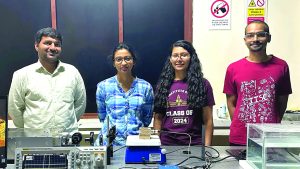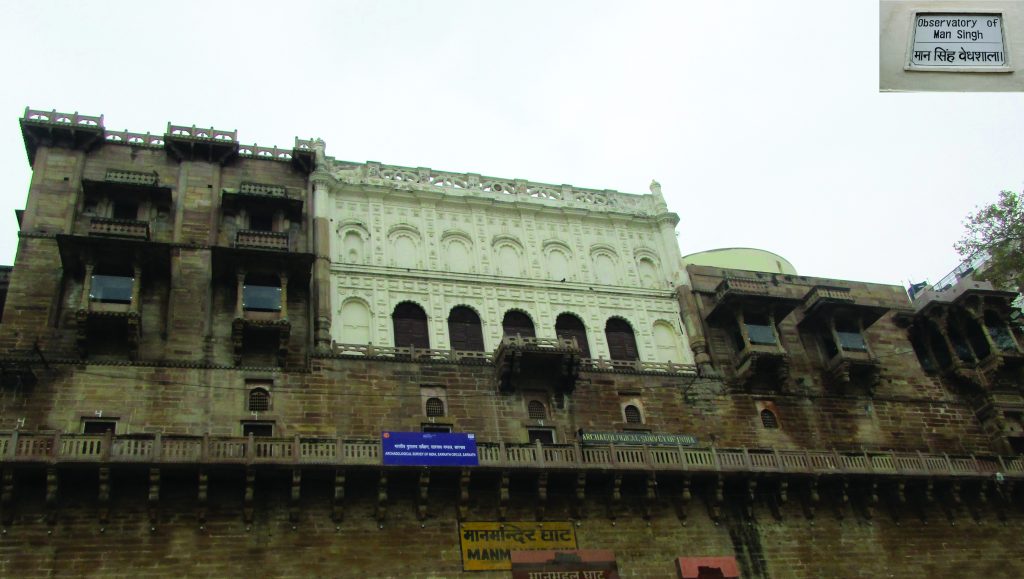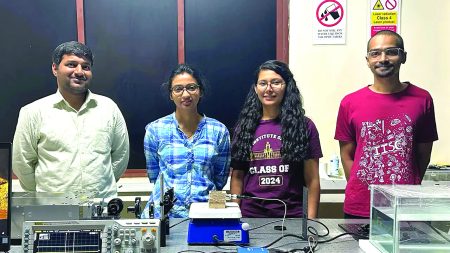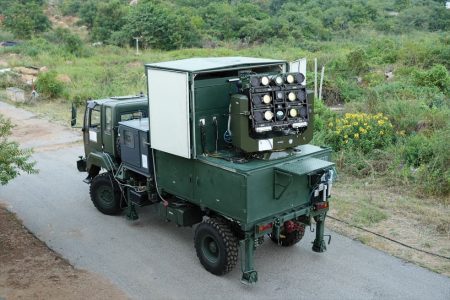Varanasi, or Kashi, is a city that transcends time. Revered as the abode of Lord Shiva, the mystic city has been a cradle of spirituality, arts, culture, knowledge, salvation, philosophy, logical thought and scientific inquiry for millennia. Among its countless treasures lies the Man Mandir Observatory, a sandstone marvel built around 1734 CE by Maharaja Sawai Jai Singh II of Jaipur. Nestled on the western bank of the Ganga, near the ancient Dashashwamedha Ghat, this observatory stands as a testament to India’s profound astronomical heritage. It bridges the gap between ancient wisdom and the universal quest to decode the cosmos, offering a glimpse into the ingenuity of India’s medieval astronomers.
The Man Mandir Observatory, also referred to as the Kashi Observatory, standing at latitude: 25°18’28.23” N and longitude: 83°0’38.63” E, is a part of Man Mahal, a fort built by Raja Man Singh, an ancestor of Jai Singh II. Its design owes much to the brilliance of Pandit Jagannatha Samrat, a renowned astronomer and mathematician. The Man Mahal Observatory is one of the five observatories constructed by Raja Sawai Jai Singh at Delhi, Ujjain, Jaipur, Varanasi and Mathura. Out of these, the Mathura observatory ceases to exist today, while the other four observatories have stood the test of time. Currently, under the protection of the Archaeological Survey of India, the observatory continues to inspire scholars and stargazers alike.


THE HUMAN QUEST FOR COSMIC UNDERSTANDING
Since antiquity, humanity has sought answers to existential questions—Who am I? Where am I? How does the universe function? This quest led to the birth of astronomy—a discipline that blends art, craft, and science. Early astronomers relied on naked-eye observations, but as the limitations of visual accuracy became apparent, the need for precise instruments arose. The quest for instruments began as astronomers sought to achieve observational accuracy and precision, enabling them to record celestial bodies in a spatio-temporal (space-time) context by studying their cycles of repeated appearances in the sky and the associated time scales. In India, this evolution is evident in texts and treatises like Vedanga Jyotisha, Surya Siddhanta, Siddhanta Shiromani, etc. which not only detail the concepts on observational and positional astronomy but a few of them also give literary space to describe instruments such as the Gola Yantra, Shanku Yantra, Nadivalaya, Ghati Yantra, Phalaka Yantra, Yashti Yantra, etc.
By the medieval period, astronomy had reached new heights under the patronage of kings like Sawai Jai Singh II (King of Amber, now Jaipur). Dissatisfied with outdated astronomical data, Jai Singh sought to refine calculations by blending indigenous knowledge with insights from foreign scholars. His vision materialised in the form of the Jantar Mantar observatories, with the Man Mandir in Varanasi being one of the finest examples. ‘Jantar’ is a colloquial aberration (Apabhramsha) for ‘Yantra’ (instrument) and ‘Mantar’ comes from ‘Mantrana’ (to calculate) giving the literal meaning as ‘calculating instrument’. Sawai Jai Singh II mixed foreign ideas with Indian astronomical traditions which resulted in the gigantic masonry astronomical instruments of Jantar Mantar constructed to yield advanced results.
WHY MASONRY INSTRUMENTS? THE ENGINEERING BRILLIANCE OF JAI SINGH
One might wonder why Jai Singh chose massive masonry structures over smaller, portable metallic instruments. The answer lies in his pursuit of precision. Early in his reign, Jai Singh experimented with metallic tools like astrolabes and quadrants, but these were prone to wear and tear, back-lash errors, and misalignments. Even the finest European instruments of the time, such as those used by John Flamsteed at Greenwich, were limited by their small size and susceptibility to environmental factors.
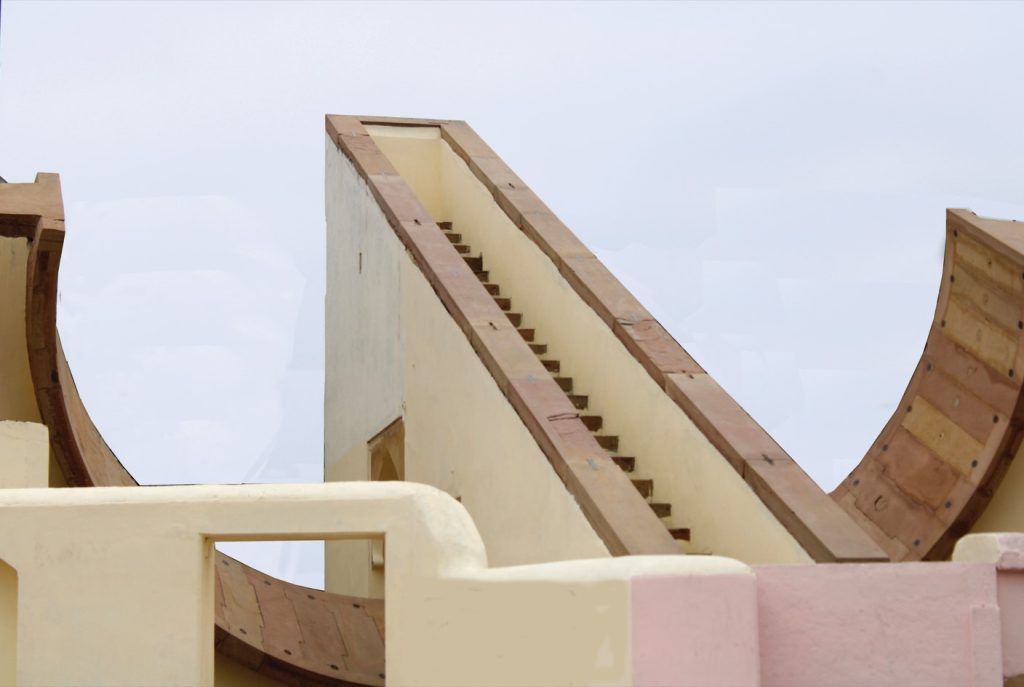

In an approach similar to that adopted by the grand observatories of Central Asia, like Ulugh Beg’s Samarkand Observatory, Jai Singh turned to masonry. Stone instruments, once calibrated in terms of astronomical coordinates, remained stable for centuries. Their sheer size allowed for finer graduations, reducing observational errors and even enabling time readings accurate to within seconds. This engineering choice, as per the belief of Sawai Jai Singh, was revolutionary—it combined the robustness of stone with the sophistication of geometric design, ensuring that the observatory’s measurements could be trusted for generations.
THE INSTRUMENTS OF MAN MANDIR: AN EXPLORATION
The Kashi Observatory’s remarkable instruments have captivated scholars across generations. Pioneering astronomers like Pandit Bapudeva Shastri, in the year 1866, left detailed records in his Kasi Manamandira Vedhalaya Varnanam, while colonial-era researchers including Robert Barker and Sir Joseph Hooker meticulously documented their findings. These accounts reveal an observatory in its prime, bustling with sophisticated instruments. Today, visitors can still marvel at many of these astronomical wonders—the towering Samrat Yantra, the ingenious Dakshinottarbhitti Yantra, and the celestial Nadivalaya Yantra, Chakra Yantra, Digamsha Yantra among them—all carefully preserved amidst the observatory’s tranquil environs. Let us dive deep into the workings of the yantras (instruments) and the celestial principles they embody.
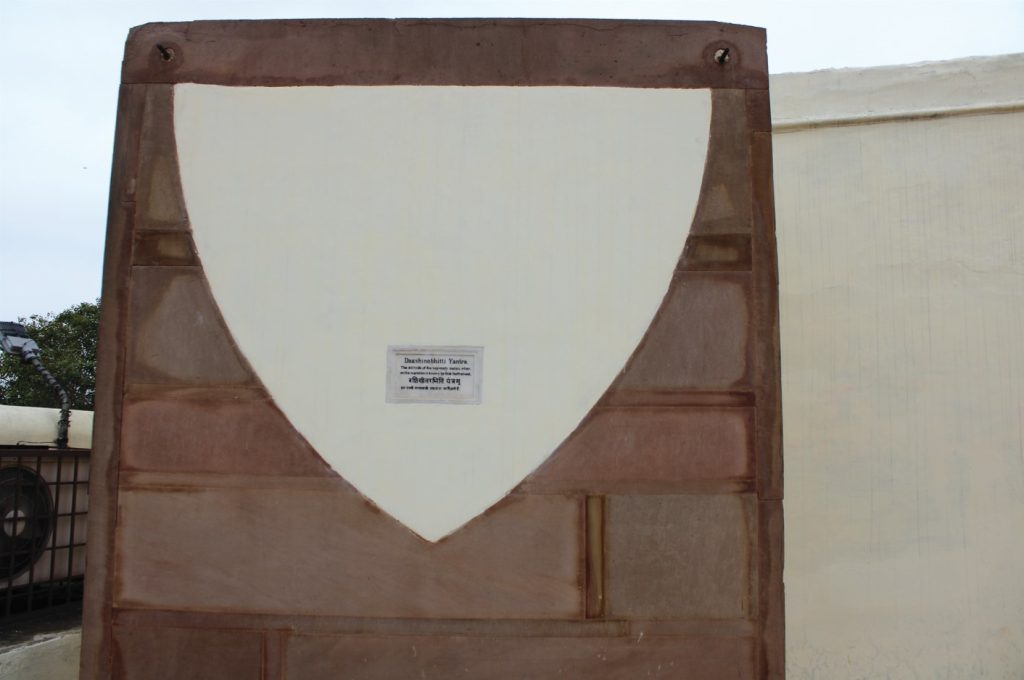

The Yantra Samrat (Samrat Yantra) stands as the centrepiece of the observatory, a massive equinoctial sundial that dominates the rooftop space (see the top image on facing page). The precisely aligned gnomon wall of Samrat Yantra runs perfectly north-south, with the upper portion angled to point directly at Polaris, the North Star. Flanking this central wall are two large stone arcs positioned on the eastern and western sides, each containing carefully marked quadrants with time divisions. As the Sun moves across the sky on clear days, the shadow cast by the gnomon travels along these quadrant scales, allowing observers to read the exact time from where the shadow’s edge falls. Beyond timekeeping, this instrument served a more advanced astronomical purpose— when equipped with a narrow metal sighting tube, astronomers could determine the hour angle of planets and stars by applying basic trigonometric principles. The Samrat Yantra could also be used to find the vishuvakala (right ascension in units of time) of stars, which could then be converted to degrees to calculate their right ascension—a fundamental coordinate in celestial mapping.
Near to this monumental sundial stands the Digamsha Yantra, designed specifically for measuring digamsha (azimuth angles) of a celestial body. This horizontal instrument features a central cylindrical pillar equipped with a gnomon and a small hole at its base. Surrounding this central pillar are two concentric circular walls—the inner wall matching the central pillar’s height, while the outer wall rises to twice that height. This tiered structure created precise reference points for determining the exact compass direction (azimuth) for celestial bodies along the horizon. The instrument’s design allowed astronomers to track how these rising and setting points changed throughout the year, particularly important for observing solstices and equinoxes.
A short distance away, the Dakshinottarbhitti Yantra (also called the Yamottrabhitti Yantra) extends vertically along the north-south line, with its eastern face featuring two gnomons fixed at the top corners (see facing page, second deck, right). Below these gnomons lie two intersecting quadrants, each drawn with radii equal to the distance between the gnomons. This configuration enabled precise measurement of celestial bodies as they crossed the meridian—the imaginary north-south line in the sky. The instrument could determine a star’s altitude (height above the horizon) and zenith distance (angle from the point directly overhead). Remarkably, it could even measure the Moon’s position by utilizing the faint gnomon shadow cast by moonlight, while for stars, these measurements were taken during their transit.
The Nadivalaya Yantra is an equinoctial sundial which presents a different approach to celestial observation. This circular stone instrument, supported between two columns, has its flat surfaces aligned parallel to the Earth’s equatorial plane (see facing page, second deck, left). A central pin points toward the North Celestial Pole, casting shadows that reveal more than just the time. The instrument’s functionality becomes apparent with the changing seasons— when the Sun or any nakshatra is in the northern celestial hemisphere, its shadow falls on the northern face’s graduated scale and the hour angle of the celestial body is determined from that scale, while during the other half of the year when the Sun or the nakshatra moves south of the celestial equator, then the south facing side with the axis protruding on the other side, having a circle helps to indicate the hour angle. This clever design automatically accounted for the Earth’s axial tilt, allowing astronomers to determine whether celestial objects were currently in the northern or southern celestial hemisphere.
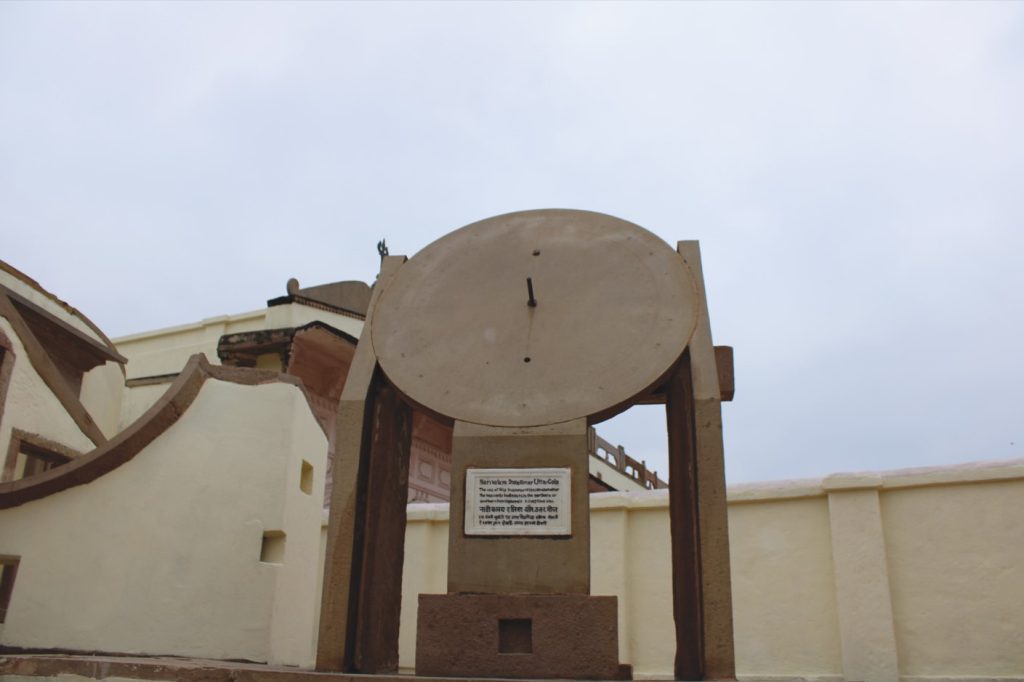

Completing this ensemble of instruments is the Chakra Yantra, a rotating iron dial mounted between two supporting walls with its central pivot diameter aligned toward Polaris. This versatile device served multiple observational purposes—its rotating disc could help measure the declination (angular distance north or south of the celestial equator) of the planets and stars. The engraved base circles provided additional reference marks for determining hour angles, essentially showing how far east or west a celestial body was from the meridian at any given time.
Together, these instruments formed a comprehensive astronomical observatory, each device complementing the others in function and purpose. Their physical arrangement on the same rooftop allowed astronomers to move efficiently between observations, with the Samrat Yantra and Laghu Samrat Yantra serving as the primary timekeeping reference while the other instruments provided specialised measurements. This integrated system enabled precise astronomical observations that supported calendar creation, timekeeping, and celestial mapping—practical applications that connected the cosmic measurements to daily life in 18th century India.
The instruments’ designs reveal sophisticated understanding of astronomical concepts. These yantras are a timeless reminder of a scientific approach that valued empirical verification. The use of Polaris alignment demonstrates the knowledge of the Earth’s rotation axis, while the equatorial alignment of the Nadivalaya Yantra shows comprehension of celestial coordinate systems. The precision in angular measurements indicates advanced geometrical knowledge, and the ability to track both solar and stellar motions, points to a comprehensive approach to observational astronomy. What makes these instruments particularly remarkable is how they translate complex astronomical principles into physical structures that can be used for practical observation without requiring complex mathematics in the field—the calculations are effectively built into their very geometry.
The instruments at Man Mandir, while representing a unique intersection of architecture, astronomy and engineering, also narrate a unique story of cosmic exploration, where shadows become data and stones transform into precise scientific tools to measure the most subtle celestial motions. The enduring presence of these instruments, centuries after their construction, testifies to both their robust design and humanity’s lasting fascination with understanding the cosmos. The Man Mandir Observatory at Varanasi represents the legacy of an astronomer king of India, and a scientific theatre of a profound dialogue between the Earth and the sky that continues to inspire the visitors, centuries after its creation.
*The author, an amateur astronomer, science communicator and writer active in STEAM education, is Principal Investigator, Astro STREAM Project, Saptarshi India (under Global Sky Partners Programme of Las Cumbres Observatory). He is the National Coordinator, Saptarishi India Asteroid Search Campaign. He is thankful to Dr K Venkataraman, Professor of Physics, PMB Gujarati Science College, Indore, Madhya Pradesh, for astronomical inputs on Jantar Mantar.


